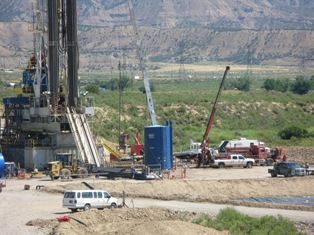USGS in past has studied connection between fracking, earthquakes in Colorado
Monday's 5.3-magnitude earthquake southwest of Trinidad in southern Colorado is being called rare but “consistent with the region and historic activity in the area,” and so far no official connection is being made to gas drilling -- or hydraulic fracturing -- of relatively shallow coal-bed methane gas reserves in the area.
But such a connection to so-called “fracking” and the disposal of fracking fluid in the local gas fields has been investigated by the U.S. Geological Survey (USGS) in the past. A September 2001 swarm of earthquakes prompted a USGS investigation.

“In recent years, a large volume of excess water that is produced in conjunction with coal-bed methane gas production has been returned to the subsurface in fluid disposal wells in the area of the earthquake swarm,” the USGS report reads. “Because of the proximity of these disposal wells to the earthquakes, local residents and officials are concerned that the fluid disposal might have triggered the earthquakes.
“We have evaluated the characteristics of the seismicity using criteria proposed by Davis and Frohlich (1993) as diagnostic of seismicity induced by fluid injection. We conclude that the characteristics of the seismicity and the fluid disposal process do not constitute strong evidence that the seismicity is induced by the fluid disposal, though they do not rule out this possibility.”
In March, Arkansas oil and gas regulators instituted an emergency moratorium on fracking to determine whether injection wells might be behind a swarm of earthquakes in that state. Fracking involves injecting large quantities of water, sand and often undisclosed chemicals into natural gas wells to fracture rock formations and free up more gas. The water is then stored in holding ponds on the surface for re-use in future “frack jobs” and is later re-injected into disposal wells.
In June, the U.S. Environmental Protection Agency (EPA) announced seven sites for an ongoing retrospective study of the impacts of fracking on drinking water supplies. One of the sites is in the Raton Basin in Las Animas County, Colo., scene of Monday's earthquake.
And Walsenburg, 35 miles from the quake in Huerfano County, in the past has had to issue assurances to its residents that municipal water is safe despite contamination of well water from gas-drilling activities.
![]() 0 Comments on "USGS in past has studied connection between fracking, earthquakes in Colorado"
0 Comments on "USGS in past has studied connection between fracking, earthquakes in Colorado"
Be the first to comment below.


 Vail Town Council to weigh new plan to redevelop T...
Vail Town Council to weigh new plan to redevelop T...  All about indexes
All about indexes  Transforming your social security into a winning r...
Transforming your social security into a winning r...  Pass sales, real estate transactions, revenues inc...
Pass sales, real estate transactions, revenues inc...  Vail Valley native with passion for Biophilic inte...
Vail Valley native with passion for Biophilic inte...  Beaver Creek starts work on new summer activities
Beaver Creek starts work on new summer activities  Land Trust, ECO Trails, Vail Resorts team up to cl...
Land Trust, ECO Trails, Vail Resorts team up to cl...  EUROVISION named Host Broadcaster for 2015 World A...
EUROVISION named Host Broadcaster for 2015 World A...  Vail Resorts brings back Lindsey Vonn's 'School of...
Vail Resorts brings back Lindsey Vonn's 'School of...  Hundreds turn out for 2015 World Championships vol...
Hundreds turn out for 2015 World Championships vol...  Eagle County Senior Health Expo and 9th Annual Hea...
Eagle County Senior Health Expo and 9th Annual Hea...  Final race of Vail Mountain Trail Running Series s...
Final race of Vail Mountain Trail Running Series s...  Before you write your will ...
Before you write your will ...  2015 World Ski Championships volunteer recruitment...
2015 World Ski Championships volunteer recruitment...  Ascent Sotheby’s International Realty in Vail an...
Ascent Sotheby’s International Realty in Vail an...  CDOT outlines road closures for local stages of US...
CDOT outlines road closures for local stages of US...  Italian artist creates unique trophies for Vail, B...
Italian artist creates unique trophies for Vail, B...  Vail Recreation District once again hosting Jake W...
Vail Recreation District once again hosting Jake W... 

